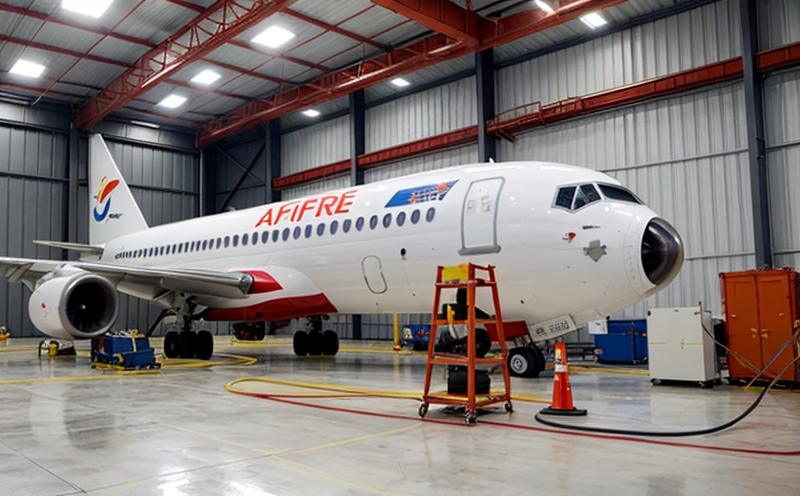Reaction-to-Fire Testing of Aircraft Lighting Panels
The Reaction-to-Fire (RFF) testing of aircraft lighting panels is a critical aspect of ensuring the safety and reliability of aviation equipment. This testing evaluates how materials and components react to fire, specifically in terms of their flammability, flame spread, heat release rate, and smoke production. These characteristics are crucial for determining whether an aircraft's lighting panel can withstand the harsh environment of onboard fires without compromising passenger safety or causing further damage.
Aerospace lighting panels must meet stringent international standards such as ISO 19450 and ASTM D6843. These standards ensure that the lighting panels can perform reliably under fire conditions, which is essential for maintaining both safety and operational integrity. The testing process involves subjecting a representative sample of the lighting panel to controlled fire conditions in an oxygenated environment.
The test typically follows these steps:
- Specimen Preparation: The lighting panels are cut into standardized specimens that accurately represent the material properties and dimensions used in actual aircraft applications.
- Test Setup: Specimens are placed in a combustion chamber where they can be exposed to controlled flames. The setup includes sensors for temperature, flame front propagation, and gas emissions.
- Data Collection: During the test, data on heat release rate (HRR), smoke production index (SPI), and oxygen consumption are captured using advanced instrumentation.
- Analysis: After the fire exposure period, the specimens are analyzed for char formation, burn-through depth, and other relevant parameters. The data is compared against specified limits to assess compliance with safety standards.
The results of this testing provide critical insights into the flammability and combustion characteristics of aircraft lighting panels. Compliance with these tests ensures that the lighting systems can operate safely in potentially hazardous environments, thereby enhancing overall aviation safety.
Understanding the importance of RFF testing is crucial for quality managers, compliance officers, R&D engineers, and procurement professionals who are involved in the design, manufacturing, or certification of aerospace equipment. By adhering to these standards, manufacturers ensure that their products meet the rigorous requirements set forth by regulatory bodies like the FAA (Federal Aviation Administration) and EASA (European Union Aviation Safety Agency).
Benefits
The benefits of Reaction-to-Fire testing for aircraft lighting panels are numerous and significant. Firstly, it ensures that materials used in these panels meet the highest safety standards, thereby reducing the risk of onboard fires and related accidents. Secondly, this testing helps manufacturers identify potential weaknesses or areas for improvement in their designs, allowing them to refine products before they reach commercial use.
Compliance with international standards also enhances brand reputation and marketability. By demonstrating adherence to stringent fire safety regulations, companies can build trust with customers and regulators alike. Additionally, successful completion of RFF testing can expedite the certification process, enabling quicker entry into the marketplace.
In terms of operational efficiency, reliable lighting systems contribute to smoother flight operations. In case of emergencies, dependable lighting ensures clear visibility for pilots and crew, facilitating safer decision-making processes. Moreover, compliance with these standards helps avoid costly recalls or redesigns later in the product lifecycle.
Eurolab Advantages
Eurolab stands out as a premier provider of Reaction-to-Fire testing services for aircraft lighting panels due to several key advantages. Our state-of-the-art facilities and experienced technical staff ensure that we deliver accurate, reliable results consistently.
- Precision Instruments: Equipped with the latest combustion analysis equipment, our laboratory provides precise measurements of heat release rates, smoke production indices, and other critical parameters.
- Comprehensive Standards: Eurolab adheres strictly to all relevant international standards such as ISO 19450 and ASTM D6843, ensuring that test results are universally accepted by regulatory bodies worldwide.
- Expertise: Our team comprises highly qualified engineers with extensive experience in aerospace materials testing. This expertise translates into detailed interpretations of test data and meaningful recommendations for improvement.
- Compliance Support: We offer full support throughout the certification process, from initial consultation to final submission of documentation.
Besides these technical advantages, Eurolab also prides itself on providing exceptional customer service. Our goal is not just to meet standards but to exceed expectations by offering timely, transparent communication and personalized attention to each client's needs.
International Acceptance and Recognition
The results of Reaction-to-Fire testing are widely accepted across international borders, primarily due to the harmonization provided by standards like ISO 19450 and ASTM D6843. These standards have been adopted globally to ensure consistent evaluation methods and comparable outcomes.
- FAA: The Federal Aviation Administration recognizes these tests as a critical step in certifying aircraft lighting systems.
- EASA: The European Union Aviation Safety Agency also mandates compliance with these standards for certification purposes.
- IATA: The International Air Transport Association references these test results to ensure passenger safety and operational efficiency.
The acceptance of RFF testing results by these regulatory bodies underscores their importance in the aviation industry. Laboratories like Eurolab play a pivotal role in ensuring that lighting panels meet all necessary requirements, thereby facilitating smooth compliance with international regulations.





